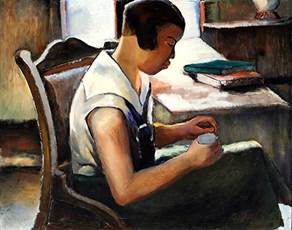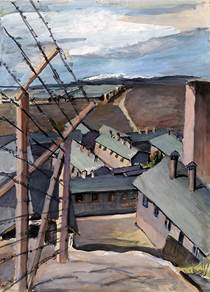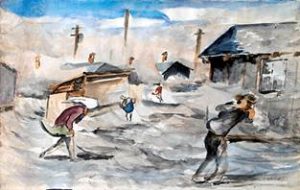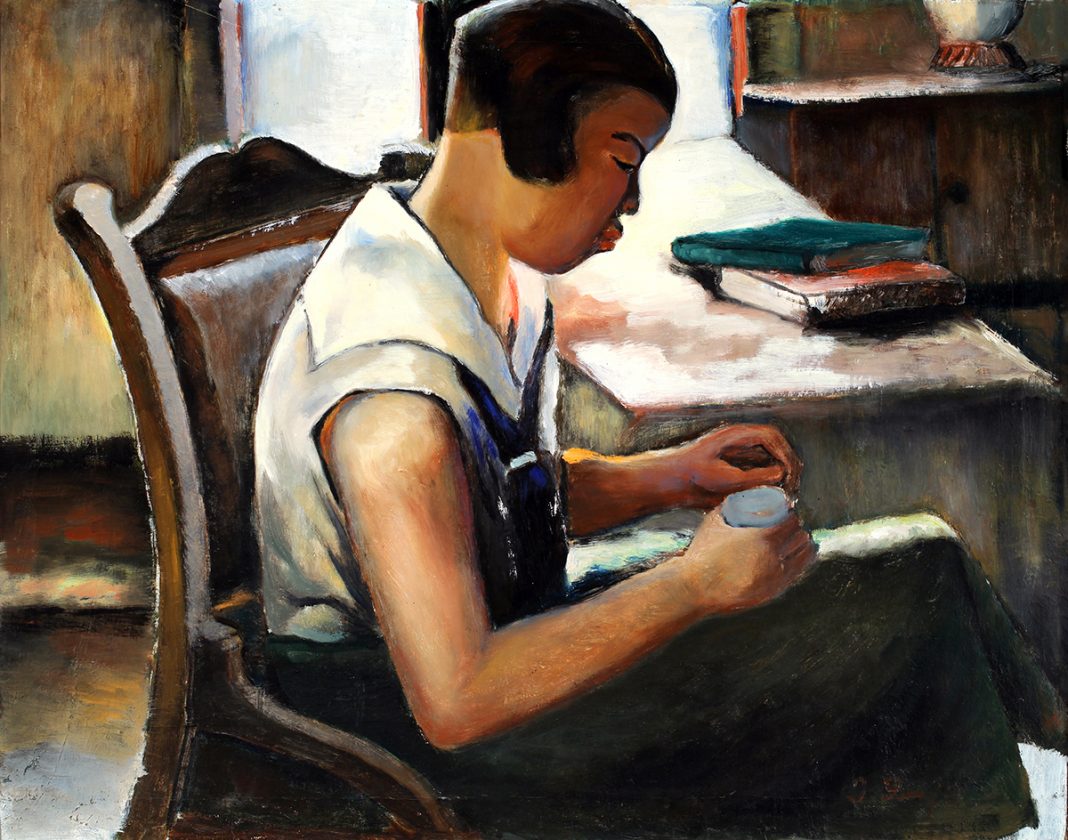Submitted by Washington State Historical Society
The Washington State History Museum is honored to open an exhibition of artworks by Takuichi Fujii. Incarcerated during World War II as a result of Executive Order 9066, his work sheds light on difficult events that most Americans did not experience, the lessons of which remain highly relevant today. Fujii drew and painted throughout the three and a half years of his imprisonment, from his forced removal in May, 1942 through the closure of Minidoka War Relocation Center in October, 1945. Witness to Wartime: The Painted Diary of Takuichi Fujii opens Saturday, September 16, 2017 and is on view through Monday, January 1, 2018.

Photo courtesy: Richard Nicol
Approximately 70 works by Fujii will be displayed, including some created before his incarceration. Visitors can also scroll through a digital version of Fujii’s nearly 400-page diary to see the evolution of his experiences and his artmaking.
“For me, the most poignant moment in the exhibition is embedded in the pages of the diary; it is a humble sketch of a door alongside his translated words, ‘Indeed this is an odd door. The lock is on the outside. I see that this relocation center is a prison,’” said Mary Mikel Stump, Director of Audience Engagement for the Washington State Historical Society. “The exhibition tells the story of Fujii’s individual will to persist, both as an artist and a citizen, and provides a rare glimpse into exactly what that experience was like.”
Seattle art historian and curator Barbara Johns based this exhibition on her new book, The Hope of Another Spring: Takuichi Fujii, Artist and Wartime Witness (University of Washington Press). Visitors to the History Museum on September 16 can join Johns for a Curator Talk and book signing at 2 PM (included with admission; free for WSHS members). They will also meet special guest Sandy Kita, Fujii’s grandson.

As Johns was working on her doctoral dissertation about first-generation Japanese (Issei) artists in Seattle, she happened upon Fujii’s wartime work. Through an unexpected online introduction, she connected with Kita, who was in the process of translating his grandfather’s diary. Kita and his wife held the collection of Fujii’s artwork, preserved by his mother (Fujii’s daughter) and grandmother (Fujii’s wife). The family wanted to share this unique record of the experience from within these domestic concentration camps.
“To find a previously unknown collection of this depth and caliber is an extraordinary experience, and doubly so to be able to bring it to public attention,” said Johns. “I’m deeply pleased that the Washington State History Museum will present Takuichi Fujii’s work—in the region in which he first made his home in America, and in this 75th commemorative year after the mass exclusion of West Coast Japanese Americans.“
During his time in Puyallup and Minidoka, Fujii created 250 ink drawings, paintings, and three dimensional works that document and powerfully convey the harsh environment, as well as the inmates’ daily routines, deprivations, experiences, and pastimes. Collectively, they present a historical record through a sensitive and personal lens, offering a view not available in the official photography of the time. They also reveal Fujii’s remarkable resilience and perseverance in continuing his project until he left Minidoka in late 1945. Through art-making, he resisted the controls on his life in order to tell his own story.

Takuichi Fujii immigrated to Washington in 1906. He settled in Seattle, established a business, married, and raised two daughters. After Japan attacked Pearl Harbor, President Franklin D. Roosevelt signed Executive Order 9066 authorizing the removal of people of Japanese ancestry to “prescribed military areas.” (See the full text of Executive Order 9066 at the National Archives website.) Fujii?50 years old at the time?and 110,000 others along the West Coast were forced to leave their homes. He and his family were sent first to a temporary detention camp in Puyallup on the Washington State Fairgrounds, and later confined at the Minidoka War Relocation Center in Idaho (one of ten War Relocation Authority camps). Many of these families lost everything ? their homes, land, belongings, businesses, and livelihoods. After the war, Fujii resettled in Chicago, where he lived until his death in 1964.
Witness to Wartime: The Painted Diary of Takuichi Fujii is the second in a pair of exhibitions at Washington State History Museum marking the 75th anniversary of Executive Order 9066; it follows Filled with Grace – Japanese Americans in the South Sound, which was on view from February through May, 2017. The Historical Society welcomes all to commemorate this chapter in our nation’s history.
The Washington State Historical Society partners with our communities to explore how history connects us all.
Hours: 10:00 a.m. – 5:00 p.m. Tuesday through Sunday. On the Third Thursday of each month, 10:00 a.m. – 8:00 p.m.
Admission: Free for members; $12 for adults; $8 for seniors, students and military veterans with ID; free for children 5 and under. Patrons with a Washington Quest card can attend for $1 per person or $2 per family. Admission is free after 3:00 p.m. on the Third Thursday of each month when the museum stays open until 8:00 p.m.













































